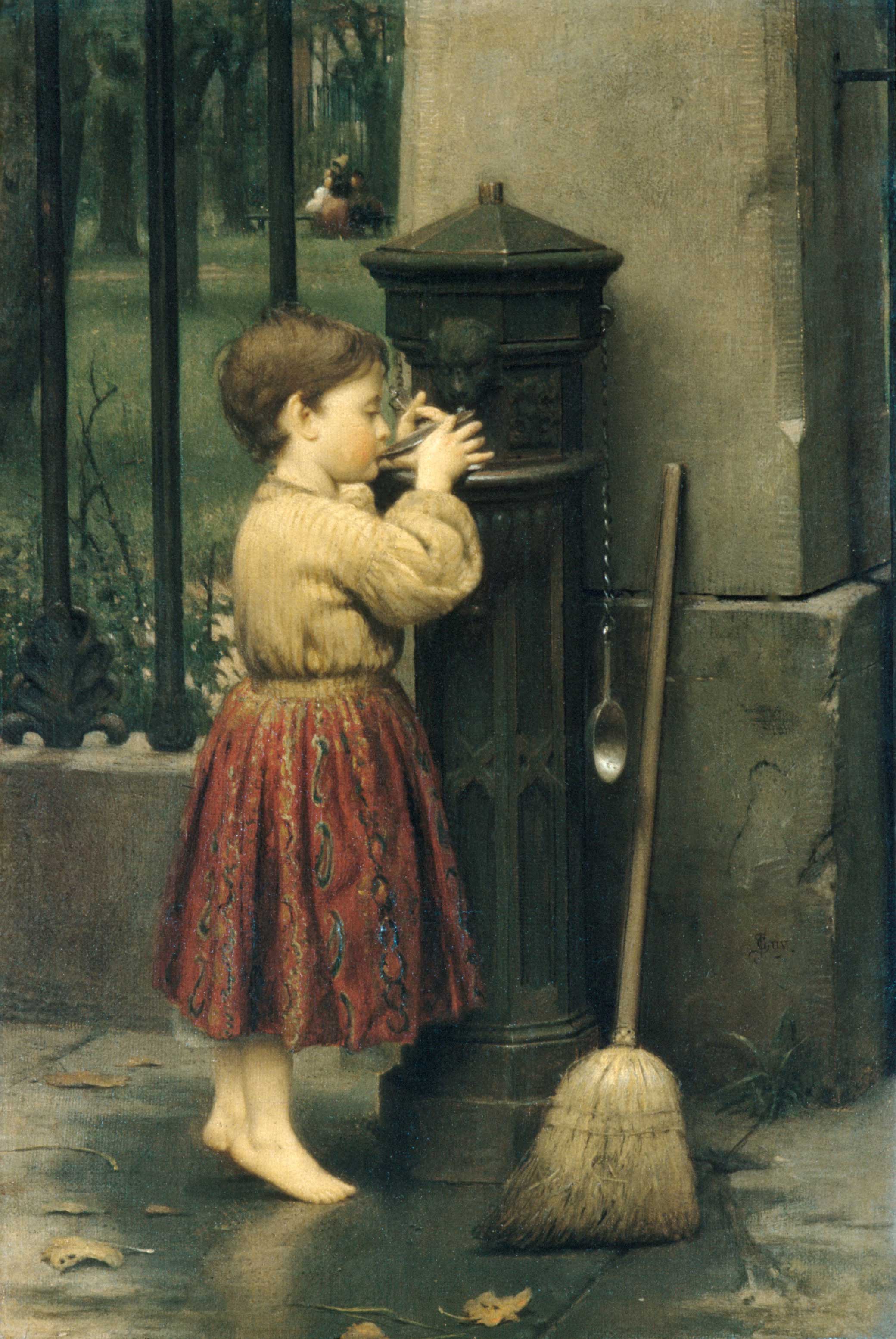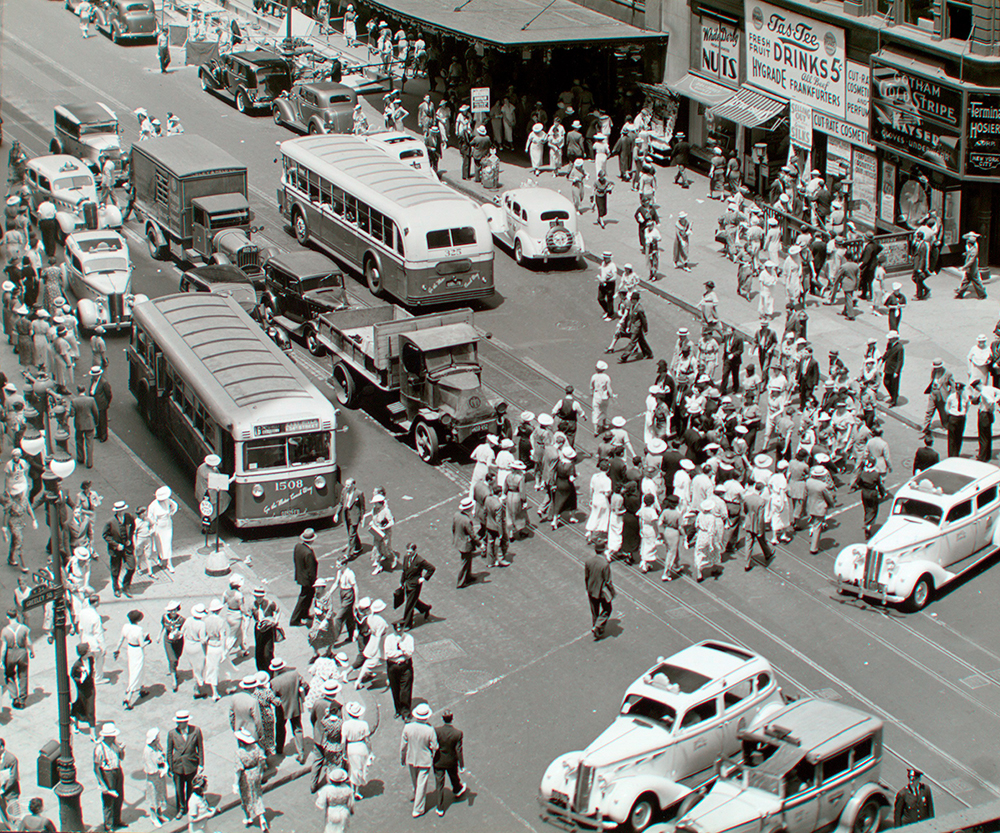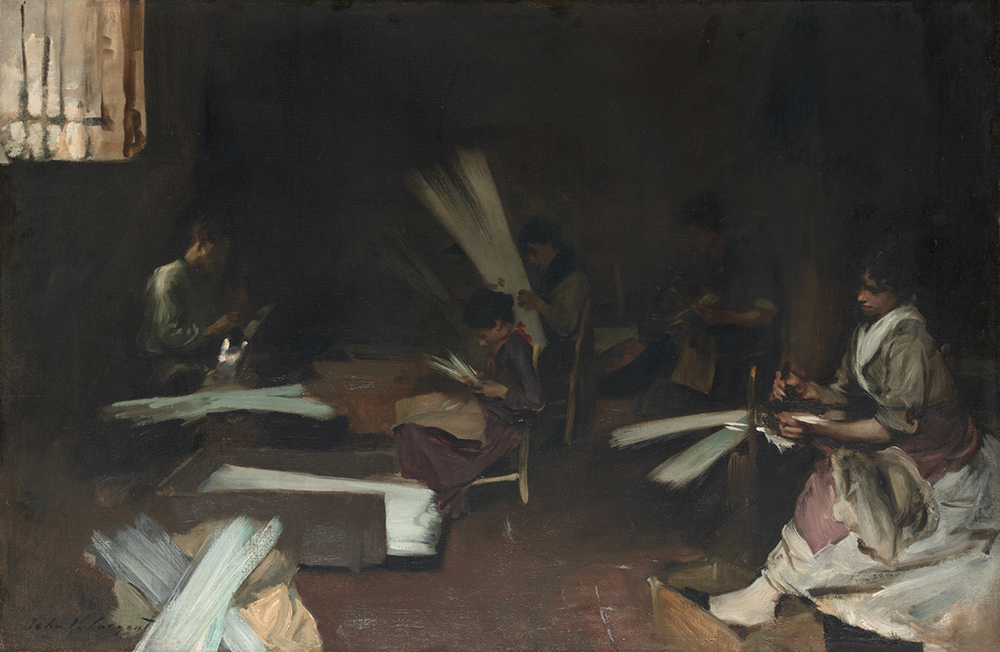
The Crossing Sweeper, by Seymour Joseph Guy, c. 1860. The Metropolitan Museum of Art, bequest of Collis P. Huntington, 1900.
The Massachusetts-based writer and teacher Annie Payson Call began her 1905 health manual Freedom of Life with an anecdote so vivid it might send any burned-out employee in 2022 into a fit of bitter recognition:
“I am so tired I must give up work,” said a young woman with a very strained and tearful face; and it seemed to her a desperate state, for she was dependent upon work for her bread and butter. If she gave up work she gave up bread and butter, and that meant starvation.
Alas! This worker’s plight is as old as industrial capitalism itself. But who is to blame for her desperate state? Call, a nationally recognized teacher of “nerve training” who had developed sophisticated techniques for self-soothing, wrote in the idiom of a self-help guru; she was resistant to linking personal discomfort and systemic iniquities. “It is not the work that tires you at all,” she tells this anonymous woman, “it is the way you do it.”
If you, transported to the turn of the twentieth century, were to visit Call in her private office on Arlington Street in Boston with similar complaints of nervous strain, the advice she would offer might strike you as rather contemporary. Call told the overtaxed young woman to perform her job “the lazy way,” by tensing only the muscles directly engaged in the task at hand and relaxing those that weren’t. As an illustration, Call asks the reader to imagine the feeling of holding a pen “with much more force than is needful, tightening your throat and tongue at the same time.” By adopting a looser mode of gripping, she argues, “ten pages can be finished with the effort it formerly took to write one.” Anyone, she seems to suggest, can manage long hours of demoralizing labor if only they can learn to relax. She prescribed breathing exercises, mindfulness, and cognitive reframing for all sorts of ills. After weeks of following Call’s regimen, her patient still faced the same predicament but now met it “with a smiling face, better color, and a new and more quiet life in her eyes.”
The wide range of patients Call describes in her book fare well under her tutelage—not only the overworked but the agitated; the sleep deprived; the easily annoyed; those overcome by fear of the dentist; and even, in her later work, World War I soldiers returning from the trenches. One needn’t believe in the miraculous results of her case studies to find it notable how closely her recommendations parallel modern courses of treatment. Progressive relaxation, breathing exercises, cognitive reframing—the techniques she prescribed remain the most powerful tools we possess to combat anxiety (barring those, of course, that involve pharmaceuticals or the wholesale dismantling of our economic system). Call achieved celebrity in her time, and her work would go on to influence mind-body therapies and practitioners for decades to come, even as her name has all but vanished from history books.
Born in 1853 in Arlington, Massachusetts, Call was the eldest of three children born to Henry Edwin and Emily Payson Call, both of whom came from old New England families. When Call was a teenager, her father died—or fled to Maine to start a new family (the evidence is hazy). In 1870 her mother married the physician Edward Whiston, who was the editor of New-Church Review as well as the business manager of the Swedenborgian Massachusetts New-Church Union.
Swedenborgianism, or the New Church, had a profound influence on Call’s writings. It was a Christian movement based on the writings of the Enlightenment-era Swedish philosopher and mystic Emanuel Swedenborg, an accomplished scientist and alleged clairvoyant who used breathwork to encourage his psychic visions. Swedenborgianism gained popularity in the United States with high-profile practitioners like Ralph Waldo Emerson and John Chapman (better known as Johnny Appleseed). Along with controlled breathing and a blend of scientific and spiritual inquiry, many New Church teachings, like Call’s, emphasized the power of a hidden spiritual body that could be drawn upon to heal physical illness and nervous distress.
Another major influence would come in the early 1880s, when the twentysomething Call taught elocution at Lasell Seminary for Young Women, a private university in Auburndale, Massachusetts. She was working primarily as an amateur actress when Henrietta Hovey visited the campus to give a lecture on Delsartism. The Delsarte System—still popular among performance artists of all stripes—teaches its practitioners to access emotion through gesture. These gestures, much like those later prescribed by Call, encourage the progressive release of tension from every muscle in the body except for those in active, productive use. “Withdraw energy from neck and allow head to drop lifelessly upon breast,” instructs the dance teacher Florence A. Fowle Adams in Gesture and Pantomimic Action, an 1891 text on Delsartian methodology. “Withdraw all energy from the waist muscles…Withdraw energy from back knee…Withdraw energy from lids…Relax jaw and allow it to drop lifelessly.” Call was so impressed by these techniques that she stopped teaching elocution and began offering instruction in nerve training instead. When she started writing on the subject as well, she found an audience eager to hear any advice to help them relax.
Call never married or had children, but she was survived by an impressive body of written work. She penned scores of articles, many of which were reprinted in newspapers across the country. Others were anthologized in the dozen or so books she published between 1888 and 1918 to both popular and critical acclaim. The renowned philosopher and psychologist William James cited Call as a major influence, deeming her 1891 volume Power Through Repose “a book that ought to be in the hands of every teacher and student in America of either sex.”
It was no surprise that Call’s work reached such a vast audience when it did. Between 1870 and 1920, the percentage of people living in cities doubled as both immigrants from abroad and migrants from the country’s farmlands moved into cramped tenement buildings. Cities became centers of the frenetic growth of industrialization, and city dwellers suffered as a result—often from the incessant noise of busy streets and loud, unregulated machinery.

Rapid industrialization also brought unclean air and untenable working conditions. While unions were winning battles across the country during those decades, it wouldn’t be until Franklin D. Roosevelt’s New Deal in the 1930s that most industries would start guaranteeing forty-hour workweeks and overtime pay. The Occupational Safety and Health Act, which regulated safety conditions in workplaces, wouldn’t pass for another four decades after that, in 1970. Call’s distressed young woman was likely working more than forty hours per week, with no benefits or safety net, and possibly in a room with poor ventilation, dangerous machinery, and/or an unmitigated susceptibility to fires.
Even in the upper classes, which were shielded from the grisliest environmental and lifestyle shifts of the Gilded Age (while subjecting others to them for profit), people felt a new social unease. Fortunes were made by families unaccustomed to the byzantine laws of high society, creating a wealthy new social class hungry for definitive guidance on everything from table manners to tactfully managing disputes. Magazines and newspapers devoted more and more pages to advice columns, while the presses churned out etiquette guides and self-help books at a rate faster than any previous time in American history. (William Dean Howells, in his 1885 novel The Rise of Silas Lapham, tells of an invitation to dine with the Coreys that sends the self-made Mr. Lapham and his wife into such a frenzy of confusion and indecision that they see no other option than to run out and purchase an etiquette book of their own.)
Unsurprising, then, was the surge in nervous-disorder diagnoses, from pantophobia (fear of everything) and railway spine (post-traumatic stress from train crashes) to Americanitis (William James’ tongue-in-cheek term for the vaguely defined neurasthenia), which ailed people of all social classes and baffled doctors nationwide. The breakneck pace of modernity, it seemed, was making people sick. Call had few tools at her disposal to address the larger causes of this widespread anguish, but she was able to contrive individual responses to systemic problems that at least offered some modicum of relief.
City noise keeping you awake at night? In Freedom of Life, Call evokes the anxiety of disruptive sounds and reframes them as tools for encouraging relaxation. “It is not uncommon,” she writes, “to be kept awake by a flapping curtain or a swinging door, by unusual noises in the streets, or by people talking.” Call’s recommendation? “In almost every sound there is a certain rhythm. If we yield to the sound enough to become sensitive to its rhythm, that, in itself, is soothing, and what before was keeping us awake now helps us to go to sleep.”
Driven mad by bad table manners? “I have seen a woman so annoyed that she could not eat her supper,” Call writes in her 1909 book Nerves and Common Sense, simply “because another woman ate sugar on baked beans.” The problem, she argues, is not an intellectual one—rules of etiquette are, for the most part, arbitrary—but a physical one: “Every annoyance, resistance, or feeling of resentment contracts us in some way physically.” Free ourselves from the bondage of physical tension, and the feelings of resentment, indignation, and exhaustion will melt away.
Call developed these techniques in her private practice in Boston and eventually became a regular lecturer at Lasell. As her patients thrived, her local reputation grew. Physicians began sending their exhausted patients (and in some instances their own wives and daughters) to Call’s office for treatment. Reviewers of her books raved about her methods and admired her “wonderfully sane view of life.”
Still, as a woman without a medical license or an advanced degree, Call drew suspicion along with praise. A common critique of her work was that it wasn’t rigorous or scientific enough. While her frequent appearances in Leslie’s Monthly and Ladies’ Home Journal meant she was more widely read than many of her better accredited contemporaries, they also bore the implication of feminine frivolity. Her work appeared alongside advice columns for throwing parties, improving table manners, and dressing appropriately for specific occasions. According to psychiatric nurse Sara Parsons in her 1922 book History of the Massachusetts General Hospital Training School for Nurses, a class of nursing students in the 1890s became so convinced that Call’s theories of relaxation would benefit their practice that they put in a formal request for a course of lectures by her. Their request was referred to a committee (composed of three doctors, all men who had never heard of Call) that determined “the nurses would not profit greatly by the book, but they could see no objection to their having the lectures at their own expense, if they did not neglect their own work.” The nurses ended up paying for the lectures themselves.

Condescension was not the only negative response to Call’s work. The cultural historian John M. Andrick—whose 2011 article in History of Psychology remains one of the only comprehensive accounts of Call’s biography, work, and influence—recalls a nasty scandal that rocketed her name to the front pages of both the Boston Globe and the New York Sun in June 1890. The previous December, two of Call’s pupils had suffered a nervous collapse, one physician claimed, as a result of taking her nerve-training course. The girls remained bedridden for months “with genuine symptoms of hysteria.” Their attending physician, Dr. Edward R. Utley, issued a statement to the press claiming that their condition had been induced by hypnotism.
The subsequent news coverage was mixed. Some sources attacked Call for her “mind training” methods, claiming that she had “almost shattered” the nervous systems of her two pupils; one Dr. Frederick Peterson was quoted extensively in the Sun, claiming that Call’s courses were “full of danger” and “there should be a law forbidding the use of hypnotism by anyone except a skilled physician.” Call’s colleagues and pupils, however, rushed to her defense. In the same article, one student insisted that the exercises had benefited her and her peers: “It’s a shame to say that they were the only cause of the sickness of those two girls.” Another student added, “Would you abolish gymnasiums just because one or two persons sprained an ankle?”
The episode was short-lived and ultimately failed to have a diminishing effect on Call’s career, but it was indicative of the kind of scrutiny she was more likely to receive than her male peers. One writer for the Sun weighed in on the scandal in the days that followed, hailing the potential benefits of hypnotism while blaming Call’s feminine naïveté for her pupils’ condition. “The trouble,” he wrote, “is that she substitutes her mere theoretical notions of what hypnotism is capable of doing for the actual proofs of experience for which men of science are waiting…a whimsical teacher of a girls’ school is not fitted to enter upon this exploration. She ought to be suppressed.”
Detractors notwithstanding, Call’s methods remained some of the safest and most accessible (and sometimes only) options for the overworked and nerve-afflicted men and women of her day. Her lectures and writings helped popularize relaxation techniques that persist more than a century later in self-help books like Bessel van der Kolk’s 2014 best seller The Body Keeps the Score.
Like the modern self-help authors who succeeded her, Call depended on keeping solutions to societal problems individualized for her livelihood. To the overworked young woman in Freedom of Life “who felt she had come to the end of her powers,” Call can’t offer more reasonable hours, paid leave, or a way of securing food and shelter if her job were to suddenly disappear. All Call can provide is a way back to that same work, albeit with a little more spirit and energy, producing a more contented and efficient laborer. “She has been at work now for several years,” Call writes, “and, at last accounts, was still busy, with no temptation to stop because of overfatigue.”
Still, when the situation is, as it was for that woman, “work or die,” any tools that empower people to face daily living with less misery are perhaps still revolutionary. Call established the individual as the arbiter of one’s own health and well-being and suggested tangible solutions for problems that had felt abstract and impossible. For those willing to fight for systemic solutions, the century that followed would be a battleground for change. For those who simply needed to survive, there was Call.